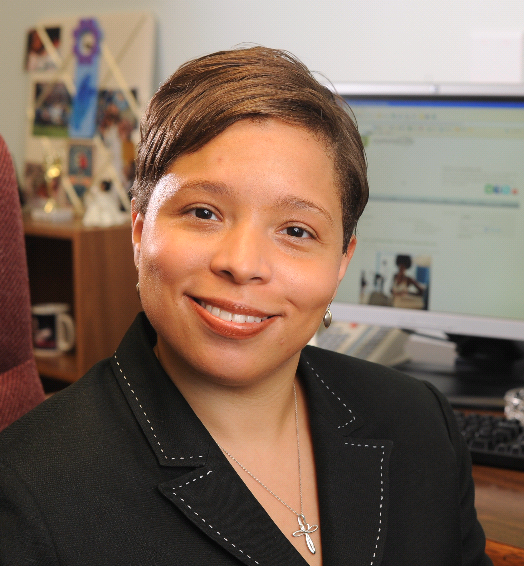 Rivers meander. With purpose, for sure (get to the sea!), but they change with the soil and substrate, shifting, bending, carving out sediment and depositing it downstream, forever adding to the complexity of a landscape. Over time they flow straighter, carve deeper into the bedrock, but there’s always that defining bend that forged a new course.
Rivers meander. With purpose, for sure (get to the sea!), but they change with the soil and substrate, shifting, bending, carving out sediment and depositing it downstream, forever adding to the complexity of a landscape. Over time they flow straighter, carve deeper into the bedrock, but there’s always that defining bend that forged a new course.So it is with many people, and with their careers, including Nerfertiti Durant’s. She began her career focused on HIV in minority populations. Then, a shift. Now, as an associate professor of Pediatrics and a member of the UAB Minority Health and Health Disparities Research Center, she is pioneering web- and social media-based methods for encouraging young black women to lose weight by increasing physical activity. In January 2014 the Centers for Disease Control and Prevention published a podcast and a study that sums up findings of her first focus group of young black women. Read more about the study here.
Durant graduated medical school at Johns Hopkins and completed a pediatric residency at Duke, focused on addressing HIV in minority populations. But between 2003 and 2006 she was in Boston, completing a master’s of public health degree at Harvard and three fellowships – one at Harvard in minority health policy and two at Children’s Hospital Boston, one in adolescent medicine and another in pediatric health policy research.
“I kept seeing young African-American girls who were obese,” she says. “That was when people were talking about the rates of obesity doubling, tripling. Obesity in children was on the rise, and most of the kids who were obese were black and Latina. I felt strongly that I wanted to address that health disparity and make a difference in it.”
So, her course shifted. She maintained a common current – minority health disparities – but she began carving away at the foundational causes of obesity in young black women. Eighty percent of black women in the United States are obese, compared with 60 percent of white women. Physical activity is key to reducing obesity and other chronic diseases such as diabetes, cardiovascular disease and cancer, all of which are disproportionately high in African-Americans.
Her initial target was the “built environment,” how cities and neighborhoods were built, because there often were barriers to physical activity. “I would tell a family, ‘Let’s try to be more active. The CDC says children are supposed to get 60 minutes of physical activity a day.’ I would give people these instructions – I was very excited about it and come up with these elaborate plans – and people would fail. They would say, ‘You give me this prescription to exercise, but I don’t have sidewalks. There are no bike paths.’”
In 2006 Durant and her husband, Reagan Durant, M.D., came to UAB as assistant professors, she in Pediatrics and Preventive Medicine and he in Preventive Medicine. Flowing with her downstream was the passion to affect change, but again her direction jogged, just a bit, to sharpen her focus.
“Young adults, children, everybody was starting to get very interested in technology,” Durant says. Everyone seemed to have a cell phone or lap top, and “screen time” was competing with physical activity. But she turned the challenge into an advantage.
“I thought, could I meet them in the middle? I wasn’t going to abandon the idea of getting children active outside, but could I make technology work in my favor. Could I harness technology to promote physical activity? If you use cell phones and social media, you can reach people anytime, anywhere, any place, rather than commit them to come into your office.”
The confluence of technology and adolescence was another advantage. Durant says there is a dearth of interventions for young women, aged 18 to 30. It’s also a time when weight gain rises and physical activity decreases. Durant said, “If we can work on this group of late adolescents and young adults, it will confer some protection on them as they age.” She was after sustained, long-term gains.
A grant from the Charles Barkley Health Disparities Fund at UAB allowed Durant to hold focus groups of young black women asking them what elements of a website would encourage them to increase physical activity. Women wanted culturally relevant information, like suggestions for hairstyles that are conducive to exercise and images of “real women” who looked like they did. This was the first step in understanding how to affect change in this group.
Grants from the Robert Wood Johnson Foundation and the American Heart Association have funded subsequent trials, and the river of knowledge has deepened. A website (loveyourheartaha.com) was created to provide social support and a protected forum for the women to engage each other. Durant gave the women tools, such as accelerometers, pedometers, heart rate monitors, and sent them messages through texting and email. The next trial will include video stories of “superstars,” women who have been in the program, struggled and succeeded in increasing physical activity and losing weight.
“We are learning there are multiple layers of complexity you have to deal with,” Durant says.
Early on, Durant did not expect the course of her career to flow through Birmingham. But, she says, “Coming here definitely allowed me to explore the technology aspect of the research and really grow. Coming to UAB was a springboard to put me in the right direction for my research career.”
She has already experienced success, but the biggest impact of her career, like that of a river, lies downstream, as methods to prevent obesity and its effects reach the sea of people who need them most.